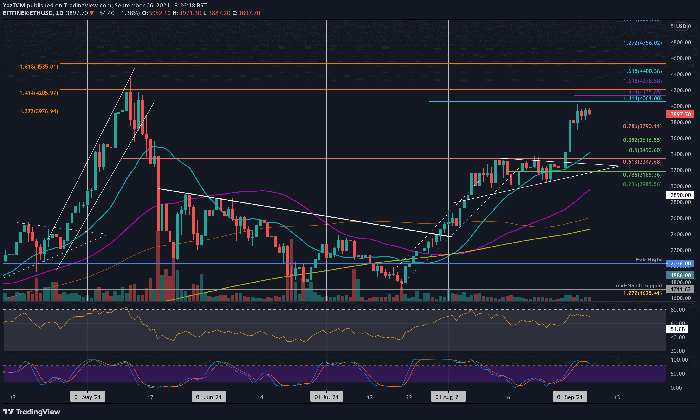Bitcoin ETFs have garnered significant attention in recent months, but recent trends indicate a troubling shift in investor sentiment. Following a period of optimism after their introduction, BTC ETFs are now witnessing a staggering $1.1 billion in outflows since February 6, 2025. This month, commonly associated with bullish Bitcoin price analysis, has instead seen dramatic withdrawals, with only a handful of days showing net inflows. The lackluster performance of Bitcoin ETFs raises questions about the future as the market grapples with February Bitcoin trends and the impact of external economic factors. As we delve into the latest Bitcoin ETF news, it becomes clear that the euphoria surrounding these investment vehicles may be waning, leaving many investors to reconsider their strategies amid the backdrop of BTC ETF outflows and fluctuating market dynamics.
In the evolving landscape of cryptocurrency investment, exchange-traded funds (ETFs) focused on Bitcoin have emerged as a popular option for traders and investors alike. However, recent reports indicate a concerning downturn in the performance of these financial instruments. After a promising start following their launch, the recent month has seen a significant reversal, with notable outflows from Bitcoin-focused ETFs. This shift has sparked discussions around alternative investment strategies as market players reflect on the implications of current trends. As we explore these developments, it’s essential to understand how factors like Ethereum ETF performance and market sentiment contribute to the overall dynamics of cryptocurrency investments.
The Current Landscape of Bitcoin ETFs
Bitcoin ETFs have recently experienced a tumultuous period, with significant outflows overshadowing the optimism that surrounded their launch. Since February 6, over $1.1 billion has exited these funds, marking February 2025 as one of the most challenging months for BTC ETFs since their inception. This downturn is particularly surprising given that February has historically been a strong month for Bitcoin price performance. However, with only four days of inflows this month, the enthusiasm surrounding Bitcoin ETFs appears to be waning.
The primary reason for this shift can be attributed to changing investor sentiment amidst geopolitical uncertainties and regulatory concerns. As investors reassess their strategies in light of President Trump’s controversial policies and their implications for the crypto market, many have opted to withdraw funds from Bitcoin ETFs. The stark contrast between the initial excitement surrounding the launch of these ETFs and the current outflows highlights a significant shift in market dynamics that will likely influence future investment behavior.
Analyzing BTC ETF Outflows
The outflows from Bitcoin ETFs can be analyzed in the context of broader market trends and investor psychology. With $364.8 million leaving the funds on February 20 alone, the pattern suggests a cautious approach by investors who may seek to minimize risk amid uncertain market conditions. BTC ETF outflows reflect a broader bearish sentiment that has emerged following the euphoria of their initial launch. Investors who once viewed these ETFs as a secure way to gain exposure to Bitcoin are now reconsidering their allocations, leading to substantial withdrawals.
In addition to political factors, the performance of Bitcoin itself plays a critical role in shaping investor decisions. As Bitcoin struggles to maintain its value amidst fluctuating price trends, ETF investors may pivot towards alternative assets or investment vehicles. This trend is particularly notable as traders seek strategies that offer potentially higher returns, further exacerbating the outflow situation for Bitcoin ETFs.
Ethereum ETF Performance Compared to Bitcoin
While Bitcoin ETFs are facing significant challenges, Ethereum ETFs have shown a relatively more stable performance during the same period. Despite experiencing some withdrawals, Ethereum ETFs have managed to maintain a more optimistic outlook, with only four days in the red throughout February. This contrasting performance indicates that investors are still finding opportunities within the Ethereum market, perhaps due to its growing use cases and advancements in decentralized finance.
The recent influx of $307.8 million into Ethereum ETFs on February 4 demonstrates a strong interest in ETH, even as Bitcoin struggles. This divergence in performance may suggest that investors are diversifying their portfolios, seeking to balance risk by incorporating assets like Ethereum, which has shown resilience amid Bitcoin’s downturn. As the crypto landscape evolves, the performance of Ethereum ETFs may serve as a barometer for overall market sentiment and investor confidence.
February Bitcoin Trends: A Market Under Pressure
February has historically been a month of positive price movements for Bitcoin, yet this year tells a different story. The stark reality of only a handful of days with net inflows indicates a growing concern among investors regarding Bitcoin’s long-term viability. As market pressures mount and global economic factors come into play, many are reassessing their positions on Bitcoin, leading to increased caution and significant outflows from ETFs.
The inability to sustain upward momentum is alarming for many traders who typically rely on historical trends to guide their decisions. This month, the combination of net outflows and a lack of bullish sentiment suggests that investors are becoming increasingly wary of Bitcoin’s price trajectory. As February unfolds, it remains to be seen whether these trends will continue or if there will be a resurgence in investor confidence that could reverse the current ETF outflow situation.
The Impact of Bitcoin ETF News on Investor Sentiment
News surrounding Bitcoin ETFs plays a pivotal role in shaping investor sentiment and market dynamics. Recent reports of substantial outflows have sparked concerns about the health of the Bitcoin market, prompting many investors to reconsider their strategies. The negative press surrounding Bitcoin ETFs can lead to a ripple effect, where apprehensive investors withdraw funds to avoid potential losses, further contributing to the downward spiral of Bitcoin prices.
Conversely, positive news regarding Bitcoin ETF approvals or regulatory developments can create a surge of optimism, encouraging new investments. As such, staying informed about Bitcoin ETF news is crucial for investors looking to navigate the unpredictable crypto landscape. Understanding how news influences market behavior can empower traders to make informed decisions, whether they choose to enter or exit the market.
Future Outlook for Bitcoin ETFs in 2025
The future of Bitcoin ETFs in 2025 remains uncertain, especially as they face mounting challenges following a period of intense scrutiny. With $1.1 billion exiting these funds, the outlook for recovery hinges on several factors, including regulatory clarity, market stability, and the overall sentiment surrounding Bitcoin. If the geopolitical and economic landscape stabilizes, we may see a resurgence in investor interest, potentially reversing the current outflow trend.
However, if current trends continue, Bitcoin ETFs may need to adapt to changing market conditions to regain their appeal. Innovations in ETF structures or the introduction of new investment strategies could be essential for attracting investors back. As we move forward, keeping a close eye on Bitcoin price analysis and market developments will be critical for understanding the trajectory of Bitcoin ETFs.
The Role of Regulatory Changes in Bitcoin ETF Performance
Regulatory changes play a crucial role in determining the performance of Bitcoin ETFs, influencing both investor confidence and market stability. The promise of a friendlier regulatory environment following the U.S. elections initially sparked interest among investors, leading to significant inflows into Bitcoin ETFs. However, as regulatory clarity remains elusive, many investors are withdrawing their funds, fearing potential restrictions that could impact the market.
As regulatory bodies continue to assess their stance on cryptocurrencies, the implications for Bitcoin ETFs are profound. A transparent and supportive regulatory framework could foster renewed investor interest, while uncertainty could further exacerbate outflows. It is essential for stakeholders to stay abreast of regulatory developments to navigate the complexities surrounding Bitcoin ETFs effectively.
Investing Strategies Amidst Bitcoin ETF Fluctuations
In light of the ongoing fluctuations in Bitcoin ETFs, investors are re-evaluating their strategies to mitigate risk and capitalize on potential opportunities. Diversification remains a key strategy, with many turning to Ethereum ETFs or other alternative investments to buffer against Bitcoin’s volatility. This approach allows investors to spread their risk across different assets, potentially cushioning their portfolios from significant losses.
Additionally, adopting a more active trading strategy may prove beneficial as market conditions evolve. Timing the market based on Bitcoin price analysis and understanding trends can enable traders to make more informed decisions regarding their ETF investments. As the crypto landscape continues to shift, adaptive strategies will be crucial for navigating the complexities of Bitcoin ETFs.
Investor Psychology: Understanding the Shift in Bitcoin ETF Interest
The recent shift in investor interest away from Bitcoin ETFs can be attributed to underlying psychological factors that influence trading behavior. As market sentiment turns bearish, fear and uncertainty can trigger a herd mentality, prompting investors to withdraw their funds in anticipation of further declines. This psychological aspect plays a significant role in driving BTC ETF outflows, as individuals react to perceived threats in the market.
Conversely, periods of optimism can lead to a surge in inflows, as investors become more willing to take risks in pursuit of potential gains. Understanding these psychological drivers is essential for both traders and analysts, as they can significantly impact market dynamics. By recognizing the factors that contribute to shifts in sentiment, investors can better navigate the complexities of Bitcoin ETFs and make more informed decisions.
Frequently Asked Questions
What are the recent trends in Bitcoin ETFs regarding BTC ETF outflows?
In February 2025, Bitcoin ETFs have experienced significant outflows, with over $1.1 billion withdrawn since February 6. This marks an alarming trend, as outflows dominated 9 out of the last 11 trading days, making February one of the worst months for BTC ETFs since their inception.
How is the performance of Bitcoin ETFs compared to Ethereum ETF performance in February 2025?
While Bitcoin ETFs have faced substantial net outflows this February, Ethereum ETFs have fared better, with only a few days of withdrawals. Although Ethereum ETFs saw some inflows initially, the enthusiasm has waned compared to the inflows recorded earlier in the month.
What factors are contributing to the decline in Bitcoin price analysis related to Bitcoin ETFs?
Recent political and economic uncertainties, including President Trump’s controversial actions, have led to decreased investor confidence in Bitcoin. This sentiment is reflected in the Bitcoin price analysis, as the lack of demand for Bitcoin through ETFs indicates a bearish outlook among investors.
What does the February Bitcoin trends indicate about investor sentiment towards Bitcoin ETFs?
The February Bitcoin trends show a stark shift in investor sentiment. Historically a positive month for Bitcoin, February 2025 has seen a majority of days with net outflows from BTC ETFs, reflecting growing skepticism among investors regarding Bitcoin’s future performance.
What are the latest Bitcoin ETF news updates regarding fund withdrawals?
The latest Bitcoin ETF news highlights alarming withdrawal trends, with $364.8 million pulled from BTC ETFs on February 20 alone. This has raised concerns about the sustainability of Bitcoin ETFs as investment vehicles, especially after a wave of initial enthusiasm following their launch.
| Key Points | Details |
|---|---|
| Bitcoin ETFs Performance | February 2025 saw significant outflows with only 2 out of 11 trading days in the green. |
| Total Outflows | Over $1.1 billion in net outflows since February 6, 2025. |
| Investor Sentiment | Investor confidence has diminished due to external factors, affecting inflows into BTC ETFs. |
| Comparison with ETH ETFs | ETH also faced withdrawals, but had fewer red days compared to BTC. |
| Regulatory Impact | The anticipated friendly regulatory environment post-U.S. elections has not sustained investor enthusiasm. |
Summary
Bitcoin ETFs are currently experiencing a significant downturn, with the month of February 2025 marking a period of high net outflows and decreased investor confidence. The initial excitement surrounding the launch of Bitcoin ETFs has faded, as external factors have contributed to a lack of bullish sentiment among investors. As the market adjusts, stakeholders are closely monitoring the evolving landscape of Bitcoin ETFs to gauge future investment strategies.
Bitcoin ETFs, or exchange-traded funds that track the performance of Bitcoin, have recently experienced a troubling trend with significant outflows. Since February 6, over $1.1 billion has been withdrawn from these funds, marking February 2025 as the worst month for Bitcoin ETFs since their inception. This downturn raises questions about investor sentiment, particularly as Bitcoin price analysis reveals a shift in market dynamics. Notably, BTC ETF outflows have dominated the headlines, while Ethereum ETF performance has shown a contrasting picture. As we delve deeper into the latest Bitcoin ETF news, it becomes evident that the once-thriving enthusiasm for these investment vehicles has waned, leaving many to wonder if the euphoria is truly over.
The recent fluctuations in cryptocurrency investment options, particularly those tied to Bitcoin, have sparked a conversation around Bitcoin exchange-traded funds. These investment tools are designed to provide a more accessible avenue for investors looking to gain exposure to Bitcoin without directly holding the cryptocurrency. However, the current trends indicate a wave of withdrawals from these funds, raising concerns about their viability in the market. Meanwhile, the performance of Ethereum-related ETFs presents a stark contrast, showcasing the diverse landscape of digital asset investments. As we explore the implications of these developments, it’s crucial to consider how factors such as BTC ETF outflows and February Bitcoin trends are shaping the future of cryptocurrency investments.















